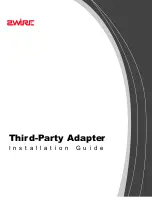
Adding CLEAR-Flow Rules to ACLs
ExtremeWare XOS 11.3 Concepts Guide
385
For example (enabling mirroring from within CLEAR-Flow rule):
cli “enable mirroring to port 7:4 tagged”
mirror add acl_rule_1
SNMP Trap
This action sends an SNMP trap message to the trap server, with a configurable ID and message string,
when the rule is triggered.
The message is sent periodically with interval
<period>
seconds. If
<period>
is zero, or if this optional
parameter is not present, the message is sent only once when the rule is triggered. The interval must be
a multiple of the rule sampling/evaluation interval, or the value will be rounded down to a multiple of
the rule sampling/evaluation interval.
To send an SNMP trap, use the following syntax:
snmptrap <id> <message> <period>
Syslog
This action sends log messages to the ExtremeWare XOS EMS sever. The possible values for message
level are: DEBU, INFO, NOTI, WARN, ERRO, and CRIT.
The message is sent periodically with interval
<period>
seconds. If
<period>
is zero, or if this optional
parameter is not present, the message is sent only once when the rule is triggered. The interval must be
a multiple of the rule sampling/evaluation interval, or the value will be rounded down to a multiple of
the rule sampling/evaluation interval.
The messages are logged on both MSMs, so if the backup log is sent to the primary MSM, then the
primary MSM will have duplicate log messages.
To send a log message, use the following syntax:
syslog <message> <level> <period>
CLI
This action executes a CLI command. There is no authentication or checking the validity of each
command. If a command fails, the CLI will log a message in the EMS log.
To execute a CLI command, use the following syntax:
cli <cliCommand>
where
<cliCommand>
is a quoted string.
Keyword Substitution
To make the SNMP trap, syslog, and CLI actions more flexible, keyword substitutions are supported in
the syslog and SNMP trap message strings, as well as in the CLI command strings.
Table 55
lists the
keywords and their substitutions.
Summary of Contents for ExtremeWare XOS 11.3
Page 20: ...Contents ExtremeWare XOS 11 3 Concepts Guide 20...
Page 25: ...1 Using ExtremeWare XOS...
Page 26: ......
Page 38: ...ExtremeWare XOS Overview ExtremeWare XOS 11 3 Concepts Guide 38...
Page 58: ...Accessing the Switch ExtremeWare XOS 11 3 Concepts Guide 58...
Page 146: ...Configuring Slots and Ports on a Switch ExtremeWare XOS 11 3 Concepts Guide 146...
Page 218: ...Status Monitoring and Statistics ExtremeWare XOS 11 3 Concepts Guide 218...
Page 240: ...Virtual LANs ExtremeWare XOS 11 3 Concepts Guide 240...
Page 248: ...Virtual Routers ExtremeWare XOS 11 3 Concepts Guide 248...
Page 278: ...Access Lists ACLs ExtremeWare XOS 11 3 Concepts Guide 278...
Page 288: ...Routing Policies ExtremeWare XOS 11 3 Concepts Guide 288 entry deny_rest if then deny...
Page 344: ...Security ExtremeWare XOS 11 3 Concepts Guide 344...
Page 393: ...2 Using Switching and Routing Protocols...
Page 394: ......
Page 454: ...Spanning Tree Protocol ExtremeWare XOS 11 3 Concepts Guide 454...
Page 484: ...Extreme Standby Router Protocol ExtremeWare XOS 11 3 Concepts Guide 484...
Page 514: ...IPv4 Unicast Routing ExtremeWare XOS 11 3 Concepts Guide 514...
Page 530: ...IPv6 Unicast Routing ExtremeWare XOS 11 3 Concepts Guide 530...
Page 538: ...RIP ExtremeWare XOS 11 3 Concepts Guide 538...
Page 556: ...OSPF ExtremeWare XOS 11 3 Concepts Guide 556...
Page 566: ...OSPFv3 ExtremeWare XOS 11 3 Concepts Guide 566...
Page 589: ...3 Appendixes...
Page 590: ......
Page 640: ...CNA Agent ExtremeWare XOS 11 3 Concepts Guide 640...
Page 670: ...Glossary ExtremeWare XOS 11 3 Concepts Guide 670...
Page 698: ...Index ExtremeWare XOS 11 3 Concepts Guide 698...
















































